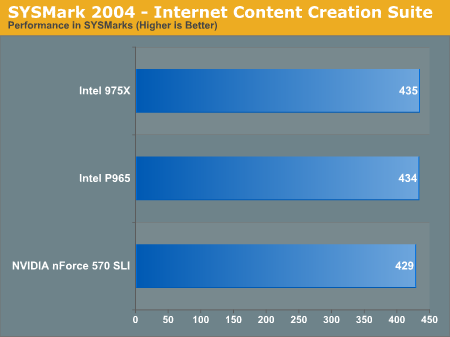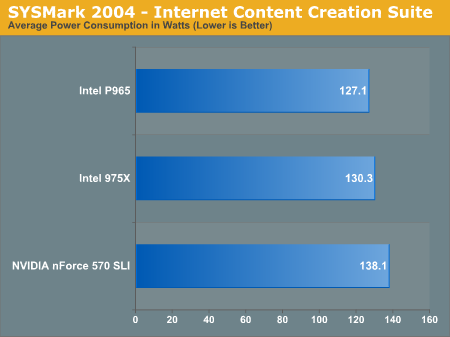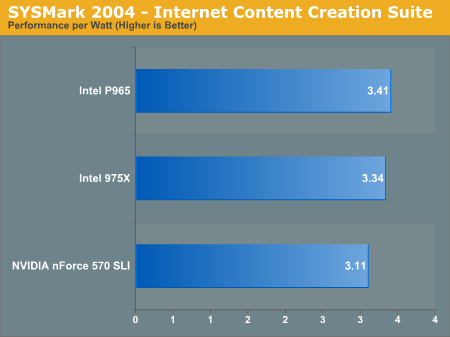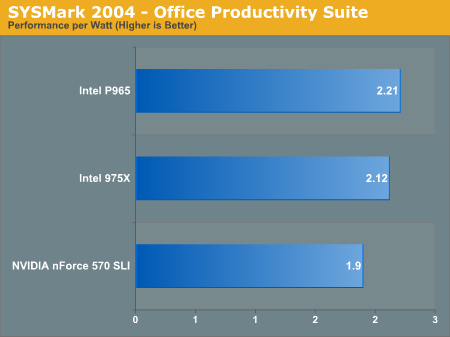Intel Core 2 Chipset Power Consumption Shootout
by Anand Lal Shimpi on October 12, 2006 12:53 PM EST- Posted in
- CPUs
Application Performance & Power Usage with SYSMark 2004
We start out with SYSMark 2004's Internet Content Creation suite, and from a performance standpoint all three chipsets perform within the margin of error for this benchmark:

Power consumption however is a far more interesting graph than performance, as there is a clear difference between the three chipsets. Intel's P965 comes out on top (in a good way), with the system drawing an average of 127.1W, followed by the 975X with a 2.5% increase in power usage and finally NVIDIA's nForce 570 SLI at 138.1W. While the difference between the P965 and 975X isn't too great, NVIDIA's nForce 570 SLI draws an average of 11W more than the P965, or 8.6%.

Given that all three platforms perform the same, the performance per watt graph isn't very alarming - the lowest power consumer gets the best performance per watt.

The Office Productivity suite in SYSMark 2004 has the nForce 570 SLI slightly underperforming, with the P965 weighing in about 4.5% faster, but still nothing significant.

Once again, it's the power consumption charts that are the most interesting; with a lighter CPU load, the power consumption of the platform manages to stand out more and here the nForce 570 SLI uses 11% more power than the Intel P965.

Performance being virtually equal, the performance per watt graph tells us exactly what we expected to see:











44 Comments
View All Comments
Magendanz - Thursday, October 12, 2006 - link
The days of ATI building chipsets for Intel CPUs may be numbered, but I'd be interested in seeing how their current offerings compare to nVidia and Intel.Also, how does integrated graphics change the power equation?
Questar - Thursday, October 12, 2006 - link
I would never consider power consumption in choosing a chipset. Two or three watts of pwer consumption isn't even worth spending any time considering imho.
falc0ne - Saturday, October 14, 2006 - link
yeah the same to me, I think for the average user power consumption of a chipset will never be a primary criteria when buying a new MB/platform. For the enterprise/business customers..that's another matter. These mbs here in the test were for the average user though.. I don't see what's with all the fuzz on performance per watt(power consumption) issue lately, at least when the differences are so minor..I'm looking forward to a thoroughly investigation on core 2 duo platforms..till then, keep up with the good work Anand..you are still my best:)
smilingcrow - Saturday, October 14, 2006 - link
For those wanting power consumption data on older chipsets that support C2D, which also includes consumption at idle, http://forums.silentpcreview.com/viewtopic.php?t=3...">See herehubajube - Thursday, October 12, 2006 - link
Yep, don't care about power consumption of the chipset. Also, if you're looking at business machines for 10,000+ users, you aren't going the custom build route as the costs to build aren't worth the savings on parts. You're going to go with a canned solution and most of those machines have low power draws anyways (no fans, low wattage power supplies, bare bones components).phusg - Friday, October 13, 2006 - link
Guys if you don't care about chipset power draw then why bother reading the article (assuming you even did) and why even bother replying to the forum?!? Sheesh.Madellga - Friday, October 13, 2006 - link
Dells and HPs (canned solutions) also use those chipsets. There are "canned" workstations also, for CAD work for example. They are not barebones, although cheap components could be used.Low wattage PSUs do not translate in lower consumption. A 500W rated 80% at 100W consumes the same as a 300W rated 80% at 100W. Most likely the canned PSU will be a cheaper one and consume more.
Corporate purchases are Global Sourced and they go for the cheapest. No corporate buyer will pay a cent more on every computer to have an Enermax PSU, for example.
Madellga - Thursday, October 12, 2006 - link
Wrong. Can you imagine in a office?In a large corporation, or gov. office, that has more than 10000 computers.
That's a lot of money.
If you think worldwide, that's a lot of energy. You don't pay this out of your pocket, nevertheless it is money wasted that could go somewhere else.
In the long run, it's also contributing to Global Warming and other pesky effects.
yyrkoon - Friday, October 13, 2006 - link
Except that a large corporation wouldnt be using this type of otherboard most likely to begin with.I have to agree with the OP, in that a few WATTS is no big deal here, however, CPU / GPU power usage can be, and often is.
I know that one thing is for sure, IF I ever use SLI, its going to be a mid ranged card that uses much less power, as I dont feel that 1 KW is nessisary for hight end PC (which is how much future PCs are going to be needing at this rate).
peternelson - Friday, October 13, 2006 - link
In a COLD country making little use of air conditioning, the excess power consumption from pcs would actually warm up the office and SAVE MONEY AND ENERGY in building heating costs. Also the electricity might be nuclear or green, whereas the building heating is more likely oil or gas (fossil fuels being depleted making green house gases and co2).
If you live in say Texas or the Sahara desert, it would of course increase your aircon costs.
Anyway I was interested in how the 590 chipset performed against 570 in power consumption.